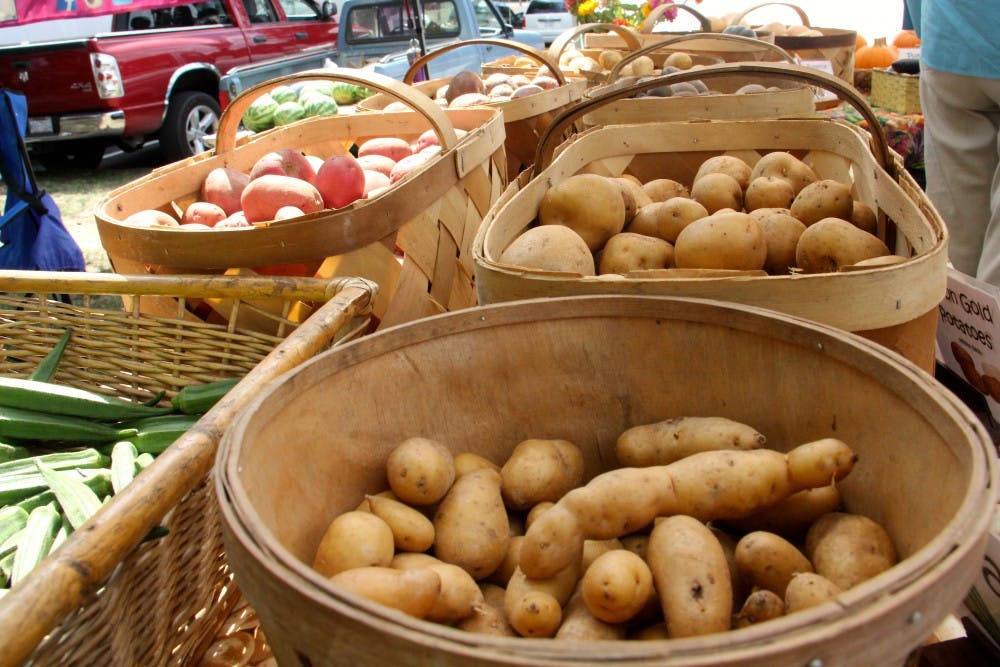The Elon Community Church farmer’s market hasn’t changed much since becoming a campus staple eight years ago. What has changed is what Elon University students, who bring in big revenue to the market after a quiet summer, look for in farmer’s market products.
“More students are buying meat here at the farmer’s market than I’ve ever seen,” said Noah Thompson of T-5 Farms, a family-run farm in southern Alamance County. “They’re liking the way we’re growing it better than the stuff at the grocery, with all of the stuff going on with chemicals and antibiotics in food.”
Foods that aren’t genetically modified and avoid synthetic chemical inputs have grown in appeal among young adults. According to a Aug. 2014 Pew Research survey, 57 percent of U.S. adults aged 18-29 said genetically modified foods are unsafe. Of the remaining respondents, 39 percent said they are safe for consumption, and 4 percent were unsure.
“My friend and I came here because we were already sick of dining hall foods and processed foods,” said Elon first-year Hannah Benson. “I’ll definitely be coming back here after seeing all the healthy options.”
Local and organic food choices at the farmer’s market include vegetables, meat, cheese, eggs, baked goods, seasonal fruits and honey products.
Sandra Sarlinga, coordinator of the Elon Community Church farmer’s market, said students are looking for transparency in food producers, which the market can provide.
“I’ve seen a lot of students asking recently about how the food here is grown,” Sarlinga said. “It’s easier to ask questions about the food here than at a big store, since the people that grew it are right there to answer your questions.”
It also helps that the majority of food vendors at the farmer’s market have organic certification through the USDA, which requires the products to use at least 95 percent organic ingredients.
Redbud Farm, a vegetable farm in Alamance County, is one of the certified organic vendors at the farmer’s market.
“When you see the USDA organic seal, there’s just no question,” said Redbud Farms co-owner Nancy Joyner. “People know it’s grown safely.”

For some students, the use of pesticides in crops that aren’t certified organic are still a concern. Pesticides are used for reducing the risk of insects, rodents, bacteria and other threats from damaging the crops but can pose health risks like nervous system damage and neurological problems when not used carefully.
The Food and Pesticides section of the Environmental Protection Agency website says that despite possible health concerns, the fruits and vegetables people eat today are “safer than ever.”
Whether genetically modified crops are inherently bad, a newer and more hot button topic, is still up for debate.
According to the website of the Genetic Science Learning Center of the University of Utah, the genetic engineering of plants can produce larger and better crops with less effort and expense. Modification can even create crops that contain vaccines or thrive in difficult weather conditions.
The website does state that risks such as toxicity or allergic reactions and cross-breeding with wild populations make genetically modified crops something that still need to be studied further.
Although the benefits of avoiding pesticides and heavily modified crops are a draw to the farmer’s market, the appeal of buying local is still the driving force behind it, Joyner said.
“I still think being able to interact and talk with local farmers trumps the organic side of things,” she said. “That way, you can build a relationship with the farmers and you can know what they’re using.”
New vendors at the farmer’s market should only increase the traffic that buying local and organic already draws in. One of the new vendors, Cookie Gurlie, sells various desserts, and other vendors selling dog treats and specialty pork have also trickled in within recent months.
“We try to bring in what the market doesn’t already have,” Sarlinga said. “You can’t have a lot of repeat vendors here, so a new vendor means a new product.”
This year’s farmer’s market will wrap up at the end of October, but drawing in more students is the current concern.
“The students bring a lot of life here after a quiet summer,” Sarlinga said. “We feel that when the students come back, things become vibrant here again. So we need to continue to build that relationship.”


